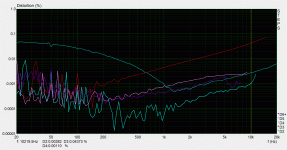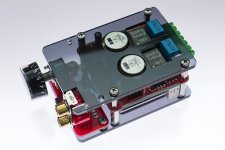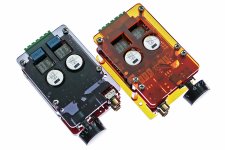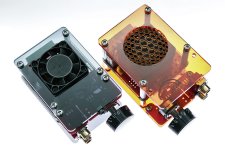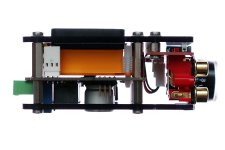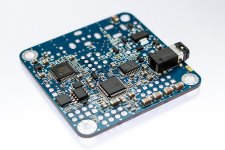Yessir😎Zero ohm jumpers are my best friends 😉 With only a dual layer PCB and such a complex routing of all the I2S lines it's inevitable. I would much rather go to town with zero ohm jumpers on the top side than interrupt the ground plane!
Apart from power & heatsink, in what way is the 3250 better than the 3251?
None, it's (pretty much) the same silicon. They lowered the default switching frequency down to 400kHz to save some idle loss power.
Yes, differential outputs, PLUS no DC blocking capacitors required.One of the DAC chips is the PCM5242, this is a relatively new chip from TI and outputs a balanced signal. This is perfect as it allows it to interface directly with the TPA3250 without any SE>BAL converters.
It would be nice to be able to find a board with this DAC chip, which includes a microcontroller for internal volume control, and LCD display.
and the ones without a soldering tag on the external vertical surface of the package are the worst
QFNs are just about doable, they would be considerably easier if tiny pins, no matter how small were added to stick out of the package, but alas.
I have soldered some packaged with balls on the underside and that was successful, some power modules from linear tech, but I hated them.
Apart from power & heatsink, in what way is the 3250 better than the 3251?
The requirement for no heatsink on top of the package gives you more freedom with component choices. The 325x family are very thin in vertical height, thinner in fact than a lot of components and especially the more chunky and better performing capacitors that you'd rather get close to the chip.
Also the heat slug on top of the 3251 acts as a ground path that should ideally be connected to the ground plane in some way. The same is true for the power pad on the bottom of the 3250 but being on the bottom gives it a direct connection to the ground plane, which in theory, should provide better paths for return currents.
How do you like the PCM5242 and PCM1861? I am in the planning stages of a project involving that same DAC and a PCM1863 ADC.
I like them very much. The performance is certainly there for the new DAC families, not quite at the level of the PCM1792 etc, but so much easier to implement and with a lot more flexibility. The integrated charge pump and I/V stages simplify designs significantly allowing for very compact layouts, which, in my case here, was necessary.
It also takes a lot of the headache out of the design with regards to layout. As everything is basically internal a lot of the mixed signal headache has been done for you on chip.
The PCM1861 is an absolute gem in those regards, it requires so little in the way of external components and supporting circuitry that adding it to current designs is a breeze. Most notably in that it does not require the usual 5V rail that ADCs typically do. Around a year ago I was searching for a simple to implement ADC for a pair of tiny active loudspeakers where power consumption was also very important. No other ADC offered the level of performance that the 1861 did, certainly not in combination with its ease of use and low power.
This brings us onto the TAS5756M. It is essentially a PCM5142 + TPA3118 inside one chip although I think the numbers on the amplifier module inside the 5756 are slightly better. This is also an awesome device.
Output from the digital side would be going to a TPA6120 HP amp, and a TPA325x power amp. So somewhat similar to your board.
Don't forget about the new OPA1622!
Yes, differential outputs, PLUS no DC blocking capacitors required.
It would be nice to be able to find a board with this DAC chip, which includes a microcontroller for internal volume control, and LCD display.
Well if the designer played their cards right it could include USB reconfigurability to allow programming of the on board DSP. Although quite flexible it would probably make sense for them to limit that to only things like biquads. The DSP on board these things really does increase the devices flexibility although writing a piece of software for USB programming would be a rather demanding. Having said that given miniDSPs ethos a USB programmable board with the PCM5241/5241 (they use essentially the same code) would seem right up their street.
Okay so as mentioned above here are some measurements for the wee little beastie.
These measurements were performed using the SPDIF input to test the absolute linearity of the DAC and amplifier stages.
First up is a measurement of ~1 watt into my 4.7 ohm load.

And now a little over 10 watts into the same load.

This is only one of the channels. I measured both and this is the one that performed the worst.
First of all pay attention to the third order harmonics, the red line. As these are balanced, bridged amps odd order distortion dominates as the even order products are cancelled by the output stage configuration.
The important linearity check, from my perspective, is the magnitude of the third order products at high frequencies and checking to see if these are in line with what the datasheet says the amplifier should be capable of. The higher frequencies are where things always start to fall apart as levels of feedback start to drop inside devices and parasitic non linearities become more dominant inside the inductors. Here though it can be seen that the levels of third order are quite similar to the datasheet, so I am happy.
The other thing that jumps out is the rising 2nd order as frequency decreases becoming more significant as output power rises. This has been confirmed, both by myself and TI, as being a 'design fault' as it were with the device. The PSRR of the device could be to blame for this and certainly the degree to which the rising 2nd order occurs is affected by altering the value of cstart. Here I am using a 0.1uF capacitor and increasing it improves things significantly but it does cause the device to start up less elegantly. 1uf does work but you can sometimes hear a hiss or wooshing sound through the speakers as it powers up.
As far as I am aware the PSRR of the device is flat with decreasing frequency, so certainly doesn't deteriorate, more it's the devices requirement for extremely low supply impedance that causes this. TI use an expensive and high power bench power supply with remote, point of load, sensing, for doing just this and as a result the performance of the amplifier isn't affected. Increasing the amount of bulk decoupling capacitance directly affects the rising distortion with more farads resulting in less 2nd order products so this is one way to help combat it. It is just a good thing that 2nd order distortion isn't particularly audible and especially at these levels. Still it's a fly in the ointment and is clearly an area TI could improve upon.
That aside the rest of the performance is very good, higher order harmonics are well suppressed staying at below 0.001% for the lower frequencies. D6+ appears quite high simply because it's grouping together every harmonic beyond the 6th into one. Individually the higher order harmonics are very low in magnitude.
One thing to note about the performance is that it gets even better at lower power levels with all of the harmonics essentially disappearing into the noise floor. Although I haven't shown an FFT plot it is essentially completely clean when the power is lowered. For me this is important as the vast majority of my listening is done at sub 1 watt levels.
These measurements were performed using the SPDIF input to test the absolute linearity of the DAC and amplifier stages.
First up is a measurement of ~1 watt into my 4.7 ohm load.
And now a little over 10 watts into the same load.
This is only one of the channels. I measured both and this is the one that performed the worst.
First of all pay attention to the third order harmonics, the red line. As these are balanced, bridged amps odd order distortion dominates as the even order products are cancelled by the output stage configuration.
The important linearity check, from my perspective, is the magnitude of the third order products at high frequencies and checking to see if these are in line with what the datasheet says the amplifier should be capable of. The higher frequencies are where things always start to fall apart as levels of feedback start to drop inside devices and parasitic non linearities become more dominant inside the inductors. Here though it can be seen that the levels of third order are quite similar to the datasheet, so I am happy.
The other thing that jumps out is the rising 2nd order as frequency decreases becoming more significant as output power rises. This has been confirmed, both by myself and TI, as being a 'design fault' as it were with the device. The PSRR of the device could be to blame for this and certainly the degree to which the rising 2nd order occurs is affected by altering the value of cstart. Here I am using a 0.1uF capacitor and increasing it improves things significantly but it does cause the device to start up less elegantly. 1uf does work but you can sometimes hear a hiss or wooshing sound through the speakers as it powers up.
As far as I am aware the PSRR of the device is flat with decreasing frequency, so certainly doesn't deteriorate, more it's the devices requirement for extremely low supply impedance that causes this. TI use an expensive and high power bench power supply with remote, point of load, sensing, for doing just this and as a result the performance of the amplifier isn't affected. Increasing the amount of bulk decoupling capacitance directly affects the rising distortion with more farads resulting in less 2nd order products so this is one way to help combat it. It is just a good thing that 2nd order distortion isn't particularly audible and especially at these levels. Still it's a fly in the ointment and is clearly an area TI could improve upon.
That aside the rest of the performance is very good, higher order harmonics are well suppressed staying at below 0.001% for the lower frequencies. D6+ appears quite high simply because it's grouping together every harmonic beyond the 6th into one. Individually the higher order harmonics are very low in magnitude.
One thing to note about the performance is that it gets even better at lower power levels with all of the harmonics essentially disappearing into the noise floor. Although I haven't shown an FFT plot it is essentially completely clean when the power is lowered. For me this is important as the vast majority of my listening is done at sub 1 watt levels.
Attachments
Also the heat slug on top of the 3251 acts as a ground path that should ideally be connected to the ground plane in some way. The same is true for the power pad on the bottom of the 3250 but being on the bottom gives it a direct connection to the ground plane, which in theory, should provide better paths for return currents.
To my knowledge, the pad is only heat transfer and should be grounded for EMI reasons. It's not a "main" ground path.
Regarding the PCM52XX, does it really needs no coupling Cs when connecting to the TPA? Aren't the PCM outputs then get lifted to TPA3250's bias voltage?
I believe there needs to be a capacitor inline as the tpa is biased to mid supply and there is no pin on the pcm51xx for biasing.
To my knowledge, the pad is only heat transfer and should be grounded for EMI reasons. It's not a "main" ground path.
Regarding the PCM52XX, does it really needs no coupling Cs when connecting to the TPA? Aren't the PCM outputs then get lifted to TPA3250's bias voltage?
It might not be the main ground path but it does have an internal connection to the other ground pins within the IC.
And yes you absolutely need the coupling caps between the PCM5242 and TPA. Did I give the impression that you didn't? The PCM5242 does have ground centred outputs so doesn't need coupling caps like other single rail driving DACs do, when driving equipment.
Hi All,
I'm using the PCM5242 as an 8 channel (4 dual chips) and I like then. As others pointed out, easy to design with and sounds very good. If my power supply ever shows up they will be driving an 8 channel TPA3251 amplifer in differential mode. Will report back if this project ever gets complete as I'm anxious to hear these!!!
Also, the hot air tools have come down in price recently. You can probably pick one up for under $100 someplace (ebay?). Makes the QFN and similar ICs easy to solder. Might be worth the investment for some as it will solder almost anything.
I'm using the PCM5242 as an 8 channel (4 dual chips) and I like then. As others pointed out, easy to design with and sounds very good. If my power supply ever shows up they will be driving an 8 channel TPA3251 amplifer in differential mode. Will report back if this project ever gets complete as I'm anxious to hear these!!!
Also, the hot air tools have come down in price recently. You can probably pick one up for under $100 someplace (ebay?). Makes the QFN and similar ICs easy to solder. Might be worth the investment for some as it will solder almost anything.
You should like the way that sounds indeed! Driving the TPA325x series with a true differential signal, instead of using a SE>DIF converter, is the way to get the most out of them. I've just installed the system above into the system for which it was intended and it sounds really good.
Class D is going to be the future. This current generation of ICs from TI is significantly better than the previous and when the generation after the 325x comes out that should completely seal the deal.
Things I'd like to see in the next generation would be eliminating the low frequency second order issue, improving internal feedback to keep the distortion rise even lower along with output stage improvements to help accomplish the same thing and possibly output filter inclusive feedback to make the amplifier load invariant.
It will be interesting to see if the higher power TPA3255 has lower distortion at equivalent (low) output powers, or if it just has higher distortion when driven harder.
Class D is going to be the future. This current generation of ICs from TI is significantly better than the previous and when the generation after the 325x comes out that should completely seal the deal.
Things I'd like to see in the next generation would be eliminating the low frequency second order issue, improving internal feedback to keep the distortion rise even lower along with output stage improvements to help accomplish the same thing and possibly output filter inclusive feedback to make the amplifier load invariant.
It will be interesting to see if the higher power TPA3255 has lower distortion at equivalent (low) output powers, or if it just has higher distortion when driven harder.
The 3255 is having slightly bigger output fets compared to the 3251/3250. So if this related to THD, chances are good.
TI has a sale (-25%) on their TPA3251D2 and TPA3250D2 eval boards.
DIY with TI - TI store
Still not bargain-bin priced but a nice discount anyway.
DIY with TI - TI store
Still not bargain-bin priced but a nice discount anyway.
Nice work as usual. If it had a USB input I would probably have to have one 🙂
Am i correct in my assumption that the ADAU1701 only does 1024 operations per cycle at <=48kHz? Would seem to add up based on quoted MIPS.
Am i correct in my assumption that the ADAU1701 only does 1024 operations per cycle at <=48kHz? Would seem to add up based on quoted MIPS.
Well, unfortunately there's no more space for another USB-I2S solution. 😀 (As i don't want to have it SMT populated on both sides. But there's another I2S in for the SRC and ADAU so a "shield" would bring in new "magic".
You're right, the DSP is fixed 50 Mips, so increasing fs to 96kHz would half the availble instructions. (Which i wont recommend as the internal ADC/DAC section will still run at 48kHz and just put out "upsampled" data)
You're right, the DSP is fixed 50 Mips, so increasing fs to 96kHz would half the availble instructions. (Which i wont recommend as the internal ADC/DAC section will still run at 48kHz and just put out "upsampled" data)
USB receivers are a nightmare, so hard to find one that does everything I want, and is also able to be done DIY. I may just have to concede and program my own.
The ADAU can still run DSP operations on I2S in/out bypassing the internal ADC/DAC sections correct?
Also, any reason you didn't go for the PCM5242 or PCM5142 with their built in miniDSP core (same 50 MIPS)? Admittedly I do find the 50 MIPS to be a bit limiting, but only because I have the (completely unnecessary) desire to run the DACs at the full 32/384 they are capable of.
The ADAU can still run DSP operations on I2S in/out bypassing the internal ADC/DAC sections correct?
Also, any reason you didn't go for the PCM5242 or PCM5142 with their built in miniDSP core (same 50 MIPS)? Admittedly I do find the 50 MIPS to be a bit limiting, but only because I have the (completely unnecessary) desire to run the DACs at the full 32/384 they are capable of.
I iterated the case-design to take care for the output caps as well. So this is pretty much the final size/height. 🙂
Om nom nom 😀
- Home
- Amplifiers
- Class D
- TPA3251d2

